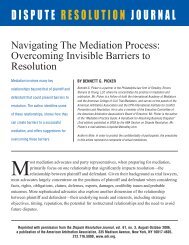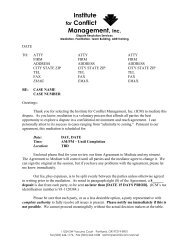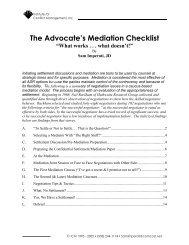17 e-Mediation - Mediate.com
17 e-Mediation - Mediate.com
17 e-Mediation - Mediate.com
Create successful ePaper yourself
Turn your PDF publications into a flip-book with our unique Google optimized e-Paper software.
Noam Ebner<br />
4.2.4 Introduction<br />
Parties to online mediation not only need an introduction to the concept and nature of<br />
mediation, they also need to understand the nature and rules of the online venue they will<br />
be employing for the mediation process. Providing parties with a tour of the platform or<br />
some initial training in its operation increases their satisfaction and <strong>com</strong>fort levels. Parties’<br />
sense that their mediator is capable with the technological platform and has a clear road<br />
map for the process affects their degree of trust in the mediator. 58 Combined, these issues<br />
would suggest the need for a new process stage, in which parties are walked through the<br />
platform (individually or jointly), and given an introduction to the online environment<br />
as it is used for mediation. Elements of this might include a site tour and tutorial, <strong>com</strong>munication<br />
ground rules, instructions for participation, <strong>com</strong>ments regarding language, time<br />
zones, synchronous/asynchronous <strong>com</strong>munication and expectations and technical support<br />
available to parties.<br />
4.3 Mediators’ Skills<br />
What would constitute a full skill-set for online mediators? Raines 59 suggests that there is<br />
no need to re-invent the wheel: online mediators require the same general skill-set of a<br />
face-to-face mediator, with added twists made necessary by technology. By contrast, the<br />
report of the Distance <strong>Mediation</strong> Project stated very clearly that “Distance mediation<br />
employs different skills, and involves a different mediation ‘style’ rather than simply new<br />
tools in the mediation tool box”, 60 and noted that mediators expressed desire for specialized<br />
training in skills unnecessary for face-to-face settings. It could be posited that by using the<br />
face-to-face mediator’s skill-set as the baseline and considering what needs to be tweaked<br />
or added, we are setting mediators up for confusion and for misapplication of techniques.<br />
In the end, both of these approaches <strong>com</strong>bined probably offer a better picture of what is<br />
needed: All tools in the traditional mediation need to be closely re-examined for suitability<br />
and application online.<br />
There are skills deemed necessary for providing face-to-face services that are simply not<br />
necessary in some online venues. Text-based mediators do not need skill in <strong>com</strong>municating<br />
via their own body language, or in interpreting others (although videoconferencing certainly<br />
does require these skills). Teaching e-mediators to consciously rely on these cues, as faceto-face<br />
mediators are taught, might be burdening them with a handicap that they will feel<br />
58 See Hammond (2003).<br />
59 S. Summers Raines, “Mediating in your Pajamas: The Benefits and Challenges for ODR Practitioners”,<br />
Conflict Resolution Quarterly (2006) 23, 3.<br />
60 Getz (2010), p. 3.<br />
388



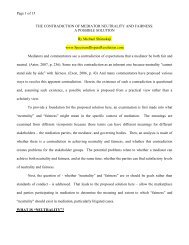

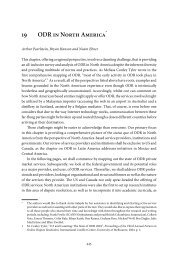
![Settlement Agreement Form [Agreement] - Mediate.com](https://img.yumpu.com/50682143/1/190x245/settlement-agreement-form-agreement-mediatecom.jpg?quality=85)






